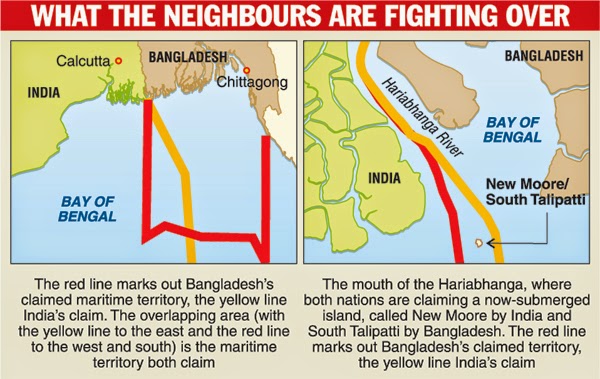India, Bangla to face off in court -December date to hear 40-year-old dispute over patch of sea by CHARU SUDAN KASTURI
India and
Bangladesh will confront each other this December in the UN’s top
arbitration court at The Hague in search of a final victory in a
four-decade-long maritime dispute over a Bengal-sized, gas-rich patch of
sea at the mouth of the Hariabhanga river.

The Permanent Court of Arbitration, the highest arbiter of territorial disputes between nation states for over 100 years, has decided to hear arguments on the dispute from December 9, senior government officials have told The Telegraph.
The court will declare its final verdict in March, the officials said. The court’s judgment cannot be challenged under international law.
“After 40 years of dispute, this is it,” an official said. “What the court decides will determine where we can fish, where we can hunt for minerals and where we can dig for oil and gas.”
The neighbours have bickered over the about 80,000sqkm patch of sea in the Bay of Bengal from 1971, when Bangladesh was born. The patch includes a disputed maritime border — 12 nautical miles off the coast of each nation — and a large economic zone over which both assert exclusive rights.
In 2009, after a dozen rounds of inconclusive talks that started in 1974, Bangladesh had approached the Permanent Court of Arbitration, followed by India later that year.
At stake is the future livelihood of millions of Bengal and Odisha fishermen, for whom the settlement could open up miles of unchallenged open sea that both India and Bangladesh currently prevent each other from using for anything other than transit. As fish near the coast are depleted, fishermen are increasingly finding themselves forced to go further out to sea.
India in 2006 also discovered 100 trillion cubic feet of natural gas in a creek about 50km to the south of the mouth of the Hariabhanga, and within the contested region. This is almost twice what the entire Krishna-Godavari basin at the centre of the corporate battle between the Ambani siblings has been shown to hold to date.
The disputed stretch starts at the mouth of the Hariabhanga, where both India and Bangladesh have claimed an uninhabited island that emerged in the 1970s after a series of cyclones and sank in 2010 amid rising water levels.
The island itself isn’t important for either nation, though India had planted a flag on it.
But whoever gets the island — called New Moore by India and South Talipatti by Bangladesh — will also gain a triangular slice of sea bordered by the river’s mouth in the north, and the island in the south.
The disputed area expands further out at sea, because of differing arguments that India and Bangladesh will make before the arbitration court. India is arguing that the maritime territory and the exclusive economic zones be demarcated on the basis of “equidistance” — equal distance from the nearest point on the coast for both nations.
The principle of equidistance, recognised under the UN Convention of the Law of Sea, is ironically the principle that helped Bangladesh win a similar dispute with Myanmar last year.
But Bangladesh is arguing that the principle of equidistance does not hold in its dispute with India, because its coast has large and frequent concave dimples.
Instead, Bangladesh is arguing, the maritime territory should be demarcated on the principle of equity — equal areas of the sea for both nations.
Bangla clashes kill 9
Nine persons were killed in violence that rocked cities across Bangladesh as the main Opposition BNP today enforced a 48-hour transport blockade to push its demand for postponing the general election scheduled for January 5 amid a standoff over the interim government that will conduct the polls, PTI reported.
A paramilitary soldier was among nine persons killed in the violence that erupted soon after the Election Commission announced the poll schedule yesterday. Over 100 people, including policemen, were injured across the country.
telegraphindia.com






















No comments